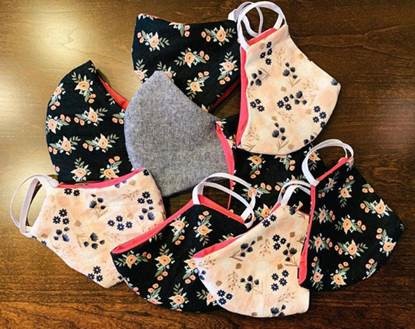Photo credit: Handmade by Amy S.
Should I wear a mask out in public during the COVID-19 outbreak?
Non-medical masks can be used by the public in situations where physical distancing (2 metres) cannot be maintained. For example, travelling to an essential medical appointment. In this case, the non-medical mask or face covering could help protect others from the spread of droplets from the wearer. This type of disease prevention is called “source control.”
If you have respiratory symptoms such as fever, cough, or runny nose, you should not be out, you should self-isolate at home. Ask friends, family, or neighbours to get any supplies you may need. There are also many businesses and non-profit organizations that can help with delivery services.
Currently, there is a global shortage of personal protective equipment (PPE) for healthcare workers who need PPE to do their work safely. When equipment like masks and gloves are used by people who don’t need them, healthcare workers can be put at risk. By using non-medical masks or face coverings, and continuing to physically distance we can both prevent the spread of COVID-19 and protect needed supplies for our healthcare workers.
Wear a mask if:
• You cannot maintain physical distancing;
• You are a healthcare worker;
• You are a caregiver of someone who is vulnerable to infection;
• You have respiratory symptoms such as fever, cough, or runny nose, and live with others; or
• You have been asked to wear a mask by a healthcare provider.
What about non-medical masks and face coverings?
If wearing a non-medical mask or face covering, it is important to do so properly. The average person touches their face over 20 times an hour. Wearing a non-medical mask can cause someone to touch their face more often, increasing the risk for infection.
When worn properly, a person wearing a non-medical mask or face covering could reduce the spread of their own droplets. Remember that physical distancing and proper, frequent hand washing remain the most effective ways to prevent the spread of COVID-19.
A non-medical mask SHOULD:
• Be safe and comfortable (i.e.: easy to breathe and talk through);
• Cover both the nose and mouth;
• Fit with no spaces between the face and the mask;
• Be taken off or changed if dirty, damaged, damp, or hard to breathe through;
• Keep its shape after washing and drying; and
• Be made of 2 layers of tightly woven fabric such as cotton or linen.
A non-medical mask SHOULD NOT:
• Need frequent fixing or adjusting;
• Be shared with others;
• Affect vision or make it hard to complete tasks;
• Be made of material that makes it hard to breathe or falls apart easily; or
• Be placed on anyone who is unable to remove it without assistance, or anyone who had trouble breathing.
Homemade masks are not medical devices and are not regulated. There are many considerations:
• They have not been tested to see if they are effective;
• They may not provide complete protection against the coronavirus;
• The edges may not form a seal around the nose and mouth;
• The fabric is not the same as used in surgical masks or respirators;
• They can be difficult to breathe through;
• They may require frequent adjustment, increasing the amount of times someone touches their face and increasing the risk for infection;
• They do not protect the eyes, another place for the virus to enter the body.
The coronavirus that causes COVID-19 spreads through droplets that come from the lungs when someone with the virus coughs or sneezes. At close range, these droplets can enter another person through the mucus membranes (eyes, nose, or mouth).
These droplets only travel about 1 metre and do not stay in the air for long. In other words, the virus is not airborne. That is why we ask people to keep 2 metres apart. We also ask people to cover their coughs and sneezes in their elbow or a tissue.
While it may not seem like much, your efforts to stop the spread of COVID-19 have a big impact. Physical distancing and proper, frequent hand washing remain the best ways to care for our community during the pandemic.
Want more information? Please view our Mask Infographic.

